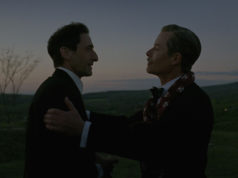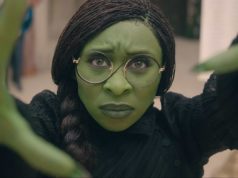The crush of business at the end of last year prevented me from posting further thoughts on the Sherlock Holmes movie when it came out last Christmas, but as a Holmes reader since my early teens, I had much more on the movie than I could put into my review of the film. Now that the DVD is out, I thought I’d get them out. Warning: Some plot spoilers ahead.
Holmes purists will no doubt quarrel with this movie on the grounds that the film’s plot is invented out of whole cloth rather than coming from any of the stories written by Arthur Conan Doyle. I would point out that many of the Hollywood movies made in the 1940s about Holmes take even more liberties with the original stories. Many of the stories have a good deal of action in them, but none of them have quite enough to supply the hijinks that Guy Ritchie and company clearly wanted. Of course, throughout the stories Holmes and Watson make teasing unexplained reference to other cases that they’ve worked. The Holmes movie could have been made from one of those, but then again, that’s been done as well.
The film does incorporate two important elements from Conan Doyle’s writing. Holmes is shown as a master of disguise, impersonating the beggar who’s knocked down by Irene Adler’s carriage. And it shows him practicing bartitsu, the composite martial arts form invented in England at the turn of the 20th century. Holmes uses the discipline (plus his own deductive capabilities) to win a boxing match. Conan Doyle caused decades of confusion by misspelling it baritsu, but bartitsu is the formerly obscure fighting method that we see here.
Lord Blackwood’s evil plot is to stage a poison gas attack on Parliament. He slips an antidote to his MP followers him the night before, so that they’ll be unaffected by the gas (a cyanide derivative) while the other MPs choke to death around them. The survivors then will believe that Blackwood really has some supernatural forces working for him. That would be quite a neat trick, but there isn’t any poison gas that works that way. Of course, Conan Doyle wrote in some big inconsistencies with the process of the snake venom in “The Adventure of the Speckled Band,” a story that’s riddled with questionable herpetology.
When does this movie take place? Conan Doyle invented Holmes in the late 1880s, and the stories (written over the next few decades) were pretty much intended to take place in the present day. However, the film has references to both the recently concluded American Civil War and Alice in Wonderland, published in 1865, which would seem to place the movie in the late 1860s. Then again, Holmes also refers to the eagle being America’s symbol for more than 100 years, which indicates the late 1870s at the earliest. Very confusing. Are there any clues in the fashions or the technology that I’m missing?
Much as I appreciate having Rachel McAdams on board, I’m not sure I like what the filmmakers have done with the character. Irene Adler only shows up in one Holmes story, “A Scandal in Bohemia,” and though she’s certainly a criminal, she’s no villain. She’s only trying to escape the clutches of the prince of Bohemia, who has hired Holmes to neutralize her as a potential blackmailer. Holmes eventually realizes that his client is the bad guy, something most private detectives (in fiction, anyway) have to reckon with at some point. The story comes pretty early in the canon, and it’s interesting that Conan Doyle dealt with this so soon. Holmes tends to hunt down criminals who get away from him, but he doesn’t go after Irene because the prince is such a douchebag.
In the movie, Irene is more of a bad girl, habitually conning rich men for their money or jewelry who may or may not be deserving of such treatment. Her husband from the story is nowhere to be found. The same goes for her career as an opera singer. (Too bad; I would have liked to hear Rachel McAdams sing Carmen or Donna Elvira.) I’m not sure why the filmmakers did this. Also, late in the film she calls him “Sherlock,” and it just seems wrong. The man Holmes has been living with for so many years doesn’t address him by his first name. Even if she’s had sex with him (as the movie implies), why does she get the privilege of using his first name?
No doubt we’ll hear more about Irene being employed (apparently against her will) by Professor Moriarty. We’ll have to see how that plays out in the sequel. I hope they cast somebody badass as Moriarty. Ian McShane seems like a natural fit. Then again, counterintuitive casting is what got us an American actor playing Sherlock Holmes, and it worked pretty well.












The key dating element is the construction of Tower Bridge. Construction began in 1886 and took 8 years; the state of its construction suggests a date of 1888 or 1889 (see various photos). This is approximately consistent with the Canonical dates of Watson’s marriage and Holmes’s first encounters with the Professor.
I didn’t find Irene Adler’s reference to “Sherlock” out of character. Mycroft also addressed him in this manner, and a female intimate would have a different relationship with Holmes than Watson’s.
I knew that was a clue of some sort. I just wasn’t sure of the name of the structure (architecture not being one of my stronger points), so I didn’t know how to look it up. The late 1880s seems a late date for Lord Blackwood to still be referring to America as “weakened” by the Civil War, but perhaps foreign affairs isn’t one of his stronger points. Thanks, Leslie.
Kristian, rewatched the movie again and found it a lot more fun the third viewing than the second for some odd reason. Anyway about the dates, I think Leslie nailed it with the Tower Bridge construction dates; also keep in mind Alice In Wonderland being written in being written in 1865 hasn’t prevented the “down the rabbit hole” being referenced even today, so no surprise it’d be referenced a mere 15 or so years after it was written. Also I think them talking about America being weak after the civil war they’re talking about the death toll the war took on America’s population of men and the troubles of reconstruction. Just my thoughts. Still thought it was a blast of a movie, though I personally can’t speak for adherence to Doyle’s stories.
Actually, Downey used Wing Chun Kung Fu in the movie, not Western pugilism, which is what Holmes would have used; and Watson, despite opportunities to demonstrate Vigny Canne, did not do so. Both were essential elements of Barton-Wright’s Bartitsu curriculum. A huge disappointment to those of us who are boosters of Western martial arts. Another missed opportunity to portray something accurately.
An early scene is Holmes shooting VR into the wall. Queen Victoria was an early and avid reader of Alice. The book has never been out of print and multiple editions were released during the 1880 – 90’s. Be sure to catch the reference to a caterpillar napping in its cocoon in the final ‘hanging’ scene.
On March 20. 1888, Watson is married and stops in to visit Holmes on the night of his appointment with the hereditary king of Bohemia. In 1883, the king had made the acquaintance of ‘the well-known adventuress’ Irene Adler; and, by 1888, she appears in Holmes’s index. The story ends with her mariage to Mr. Godfrey Norton. In the movie, when Holmes asks if she ‘sold the ring’ , she immediately describes her husband as ‘jealous, boring, and “he snores”. Then she says, ‘I am Irene Adler, again.’; i.e., divorced.
When Holmes and Watson are in prison, Watson refers to seven months worth of ‘adventures’ in his notebook. Later, his ‘scribbles’ fill a box being loaded on a cart as he moves out of Baker Street in advance of marrying Mary – apparently a timeline failure.
Interesting article and comments.